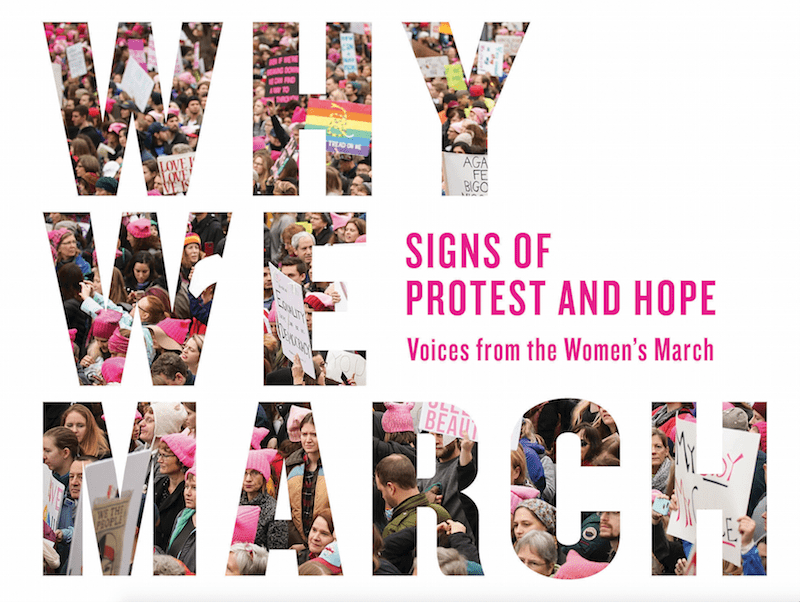An inspiring collection of images from one of the largest demos in history
From the messages on their signs to the pink hats on their heads, the fire in their eyes to the smiles on their faces, the vibrant, diverse participants photographed on this day paint a striking portrait of the Women’s March – Why We March, Introduction
Just over two months have passed by since the worldwide Women’s March and a brand new book, Why We March: Signs of Protest and Hope (Artisan, £11.99), is about to be released as a contemporary celebration of the voices of one of the largest demonstrations witnessed in recent political history.
The 264 page book, which aims to “preserve a unique moment, keep the momentum going, and inspire future marchers”, is a vibrant documentation, jam-packed with photographs which give you a taste of the thousands of creative, emotive (and downright hilarious) signs created by people of all genders (or no gender), sexualities, ethnicities and ages who marched together for women’s (otherwise known as human) rights.

The initial Women's Marches took place on 21 January 2017, the day after Donald Trump took office in the United States. Although not all directed solely at Trump’s election, his controversial inauguration was one of the major catalysts for action, with many wearing knitted “pussy hats” as a direct attack on Trump being caught on tape bragging about “grabbing” women “by the pussy”. Public figures such as Scarlett Johansson, Madonna and Alicia Keys spoke out at the main event in Washington which was originally organised through social media.
4,157,894 marchers. That's the “best guess” of two University of Connecticut Professors at the number of people in the US who marched that day, which makes the marks one of, if not the biggest march in US history.
The Women’s March on Washington’s mission statement reads: “We stand together in solidarity with our partners and children for the protection of our rights, our safety, our health, and our families – recognising that our vibrant and diverse communities are the strength of our country.

According to their home page, there have been a further 673 “sister marches”, which are marches inspired by the the original, and over 4,956,422 established “marchers”*, the impact of which – should the numbers reflect reality – is staggering.
“There have been a further 673 “sister marches” since and over 4,956,422 established “marchers”, since the initial march on Washington.”
Support worker El Wildin, 24 and from Sheffield, was at the London branch of the Women's Marches on 21 January. “It was huge. I’ve never been at a march that big, let alone one that was organised and led by women.
"Activism is usually loads of white men shouting really loudly. Where we were, people were quite timid and hesitant to chant. Our group were chanting a lot and people around us tended to just give us a round of applause instead of joining in, which I found strange.
"I think people were just shy though and a lot of people weren't used to going on protests, which is a good thing as it means it wasn't just the radical left crowd, but a more mainstream one.”
But, what are the people behind WMoW up to today? They’re still mobilising and encouraging women to register and vote in the many of the more localised or state-specific elections. Using websites like Rock the Vote, enables people to choose their state and see a list of all upcoming elections and voter-registration deadlines in an easy to navigate package, important, as WMoW states: “As we grow our resistance movement, it is important to recognise the power of our vote. By focusing on upcoming special, local, and state elections, we can create a groundswell of new elected officials who will fight for our values. Our power lies at the local level, the pipeline for higher offices.”
Why We March isn’t just another colourful coffee-table book (although, it absolutely ticks that box if that’s your bag…) As the work by WMoW is, it’s a reminder of the work that still needs to be done, of that fact that we can’t just sit back and relax now that the protests have been and gone. As Publisher at Artisan Books, Lia Ronnen writes: “The vibrant, diverse participants photographed on this day paint a striking portrait of the Women’s March – a groundswell of the resistance, love, and hope – and inspire us all to keep marching on.”
“Remember the constitution doesn’t begin with ‘I, the President’, it begins with, ‘We, the People.’”
– Gloria Steinem, in Why We March
So if you want to do your bit to continue what the marches began, you can pick up a copy of Why We March: Signs of Protest and Hope and rest in the knowledge that all royalties from the sale will be donated to Planned Parenthood, a non-profit organisation which provides reproductive health services, and is an even more crucial resource than usual for women all over the US.
And as the closing page of the book tells us, remember – the future depends on us. March on!
*the WMoW site does not state how it calculated these numbers.
